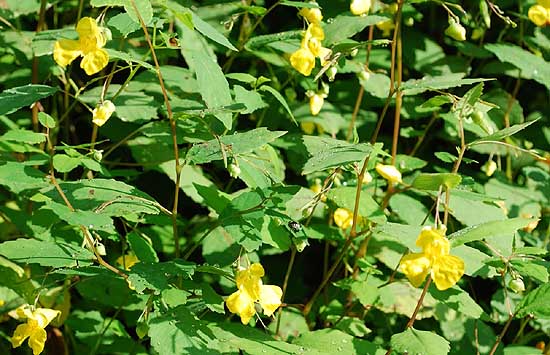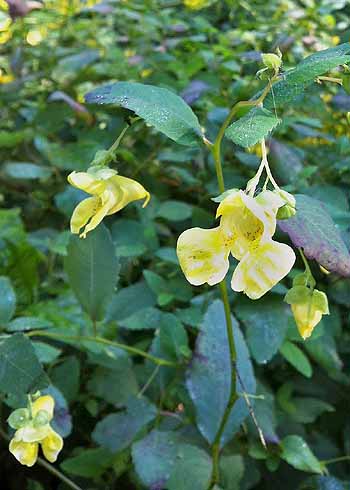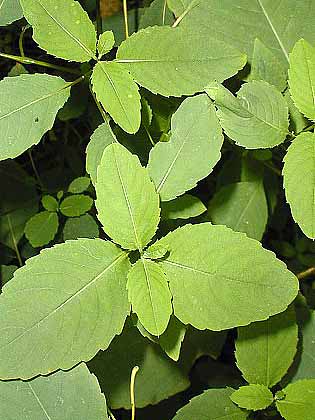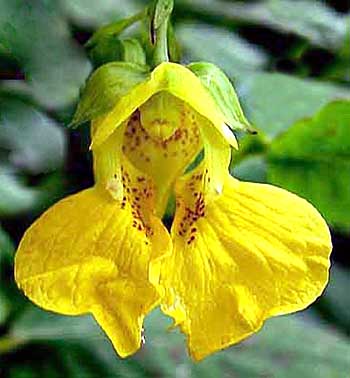This is a really lovely native annual plant for moist boggy areas. It prefers shade or semi shade and does extremely well in heavy clay soils provided there is some organic material. Once established it takes no additional care and needs no fertilizer. It will commonly self seed and return year after year. It is ideal for wetland edges, boggy wet patches and stream edges bringing bright yellow flowers that bloom from mid summer until late fall on pale green foliage that brightens the area. The leaf juice can be used to treat poison ivy so it's a great plant to have around.
Description of Pale Jewelweed (Impatiens pallida).
This is a native annual plant that can grow up to 6' in height although it is
more commonly about 3'. It has succulent light green stems which appear semi
translucent and branch frequently often making the plant into a 'thicket'. Stems,
however, break easily and it's easy to destroy the plant. The leaves are oval
shaped, pale green up to 4" long and 2" across with serrated edges
and long slender stalks that are arranged alternately on the stem. The flowers
appear in mid summer and can last until early fall, a period of 2-3 months.
They occur in clusters of 1-3 with each having a long drooping stalk with the
flower dangling on the end. Flowers are pale yellow in color and consist of
five petals fused into a cone with two large lower and one upper being prominent
and a curved spur at the back of the flower. Each flower is about 1" (2.5
cm) long and the lower petals have some red-brown spots within the throat and
nowhere else. The flowers are followed by long ellipsoid seed pods up to 2"
(5 cm) long broadest in the middle and tapered at the ends. When ripe it splits
open and ejects the seeds for some distance.
Location and Care of Pale Jewelweed (Impatiens pallida).
Likes a fairly moist soil in a semi shaded to shaded location. Ideal for the
edges of wet woodlands or marshes, stream sides or any area that stays moist
and has some shade. It does very well in heavy clay soils. Pale Jewelweed needs
some organic material in the soil so adding some to less rich soils will aid
its growth. It can grow in full sunshine in lower zones but will need shade
in zones 6 and higher, the hotter the zone the deeper the shade that can be
used. Choose a spot that allows for cooling breezes to allow good airflow. Can
brighten up shady spots with its brighter foliage and lovely pale yellow flowers.
Once established it will easily self seed and return every year with no more
maintenance needed. Pale jewelweed is a little more tolerant of dryer soils
than other jewelweeds so it can take soils that are not quite as wet, however
it does not like to dry out. Plants can become quite large as they mature so
allow enough space for them to flourish.
Ideal plant for those who have swamp or boggy areas especially those near the
home or deck as it can bring light and color to an area that does not usually
have such during the summer and fall months.
If you don't have a boggy area but wish to grow the plant you can create your
own damp bed. See creating a wet garden.
Growing Pale Jewelweed (Impatiens pallida) from seed.
Sow in a good potting soil and keep seeds moist, germination usually occurs
in 10-15 days at about 65°F (18° C). Seeds need some light to germinate
so do not cover seeds. Pale jewelweed is much more susceptible to damping
off than many other seeds so ensure that there is good airflow over the seeds.
Never place in a sealed bag, seedlings will rot. For more information on seed
growing see general growing instructions.
Edible uses of Pale Jewelweed (Impatiens pallida).
The young leaves and shoots are edible
and are often added to oriental dishes
such as chow mein and sukiyaki. They can be eaten raw in small quantities or
cooked. Some sources state that they have a high mineral content and should
only be eaten in small quantities due to possible toxicity. However there are
no references as to what the plants actually contain. Some have speculated that
it might contain calcium oxalate. The information is questionable; however,
to ensure safety do not eat in large quantities.
Medicinal Uses of pale jewelweed (Impatiens pallida).
A great plant for the relief of poison ivy (Rhus radicans). Rub the fresh leaves
on the affected area as soon as possible after touching the plant. It is also
used to treat other stings, such as nettles, burns, sprains, and various skin
diseases. The juice is combined into ointments for treatment of hemorrhoids,
warts, corns, ringworm and other skin diseases.
Leaves can be collected, juiced and then frozen for later use.
Comments
Pale jewelweed (Impatiens pallida) is closely related to the more common Impatiens
capensis (Orange Jewelweed). It is very similar in appearance to the latter
species, except that its flowers are yellow, rather than orange. Both are attractive
but pale jewelweed is considered more medically useful than the other species.
Seeds are very difficult to harvest due to the explosive nature of the pods.
Other names for pale jewelweed. Wild Balsam, Balsam-weed, Impatiens pallida, Pale-touch-me-not, Spottedtouch-me-not, Slipperweed, Silverweed, Speckled Jewels, Quick-in-the-hand, . Yellow jewelweed, Snapweed, Slippers.









